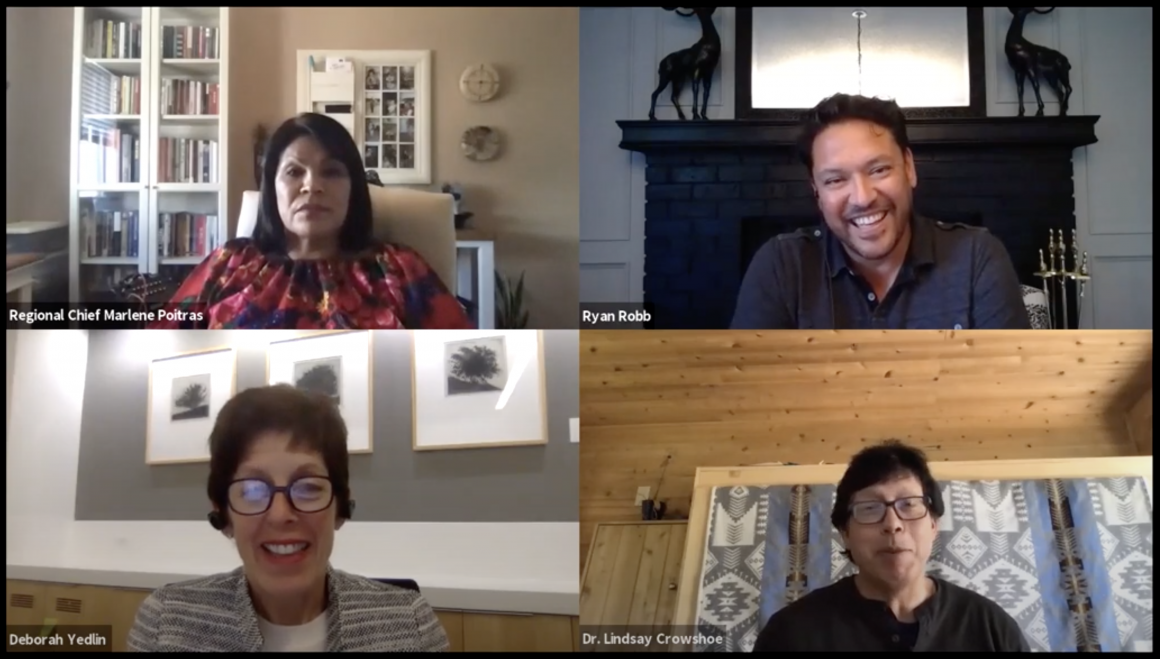
UCalgary Campfire Chats: Indigenous resiliency during the pandemic
By Duhaa Rahamatullah, June 30 2020—
To honor National Indigenous Peoples Day on June 19, University of Calgary Chancellor Deborah Yedlin moderated an online Campfire Chat to discuss Indigenous resiliency during the COVID-19 pandemic. Panelists included Dr. Reg Crowshoe, UCalgary’s Elder in Residence, Marlene Poitras, Alberta Regional Chief, Dr. Lindsay Crowshoe, UCalgary Professor and Ryan Robb, CEO of Stoney Tribal Administration.
When asked about the root of Indigenous resilience, Reg Crowshoe says it is all found in “putting the spirit back in our lives, actions and relationships.” Although the pandemic has illuminated the lack of healthcare, federal resources, mental health care facilities and education, Lindsay Crowshoe advises her community to see the pandemic as an opportunity for improvement and collaboration.
In terms of communication and cooperation of the Indigenous community with national and federal governments, Poitras believes that because of the pandemic, the Canadian government began to understand the importance of responding to the needs of the Indigenous community.
“They quickly established rights of communication, had discussions with Indigenous leaders and Alberta Health, developed pandemic plans and secured resources for the community,” she says.
Similarly, Lindsay Crowshoe discussed the improvements made to the Indigenous health care system, and says they have “pushed us a decade ahead in terms of quality healthcare options that will benefit our community.”
For example, although the ratio of physicians to indigenous patients is insufficient and requires an increase of 10 to 100 per cent, virtual medical attention has increased the number of patients physicians can attend to, and the implementation of personal protective equipment has ensured safe and flexible physician/patient relationships. Also, because the community was informed of the isolation centers required for potential COVID-positive individuals, the Indigenous community was the first community to prepare an on-reserve isolation center. Furthermore, billing codes in healthcare were experimented with during the pandemic and have been a significant improvement to the Indigenous healthcare system.
Indigenous peoples have always learned from one another: the ceremonies, the songs, it is all a practice of transferring and benefiting from others’ knowledge, Ryan Robb says, which is the root of Indigenous resiliency during the coronavirus pandemic. The community began by recognizing their underserved emergency response lines (ERPs) and using their funds to complete emergency planning on their own, based on what they had seen and learned from Canada and their past experiences with natural disasters. Like the Canadian government, they created a website exclusively for updating community members on pandemic and quarantine information. The website consisted of videos and information in English and Indigenous languages as a means of using language as a tool to spread accurate information to all generations in the community. In addition, the community incorporated an Incident Command System (ICS) system to enable an effective and efficient response to the pandemic by integrating a combination of facilities, equipment, personnel, procedures, and communication.
Among the concerns the community has with the pandemic is the mental health of community members, the insufficient federal resources allocated to Indigenous communities and lack of students pursuing education.
The pandemic has placed a mental strain on the community.
“We’re very social people, we can’t stay in. Not to mention, there are generations of Indigenous members in a single household, who are forced to stay away from one another,” says Marlene Poitras, adding that the Indigenous community statistically has higher levels of suicide, drug usage and domestic violence. According to Poitras, the community’s lack of mental health services must be combated with spiritual connection and utilizing the knowledge and advice of Indigenous leaders.
When asked about the federal resources allocated to the Indigenous community, Poitras discussed the $305 million in resources made available to Indigenous communities across Canada. Although the resources provided by the Canadian government are appreciated by the Indigenous community, $305 million is an insufficient amount because there are 634 nations across the country, and the Indigenous community in Alberta received a total of $26 million for the entirety of their population. Poitras stresses the need for federal resources in their community — the aftermath of the pandemic has resulted in inadequate funding for essential businesses in the Indigenous community, resulting in significant losses.
Furthermore, the pandemic has helped the community to recognize the barriers and negative outcomes that are a result of social contexts and inequities in education. The pandemic has taught Indigenous leaders the importance of encouraging their children to pursue education — to become the physicians, the educators, and the lawyers that will enhance the Indigenous community.
Lastly, Reg Crowshoe urges the audience to perceive the pandemic as Mother Natures’ attempt at returning to the ‘normal.’
“Mother Nature is mad at us for not respecting her,” he says. “In [an Indigenous] worldview, all creation is natural law and creation is even micro matter, which was all normal when we coexisted peacefully […] but today, [we] are commodifying these matters [and as we do that] we put everything off balance.”
Reg Crowshoe creates a parallel with the pandemic in saying that COVID “was here before us, it has always been here. We need to learn to be able to live with and cooperate with it because it has just as much a right to live as we do.”
Essentially, Mother Earth brings about challenges, the pandemic, in this case, to return to normal — to encourage mankind to coexist in peace, harmony, and unity.
The entire UCalgary Campfire Chat has been uploaded to YouTube and can be watched below.
